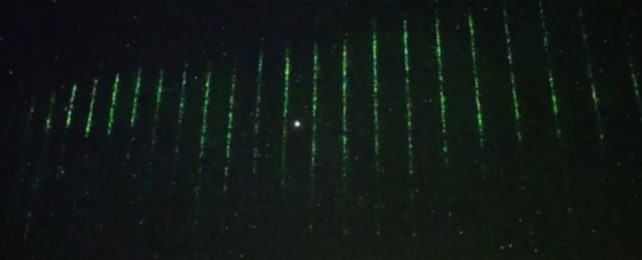Above the islands of Hawaii on January 28, a green laser was seen piercing the night sky, silently tracing a path towards the horizon like a stutter in the Matrix's code.
The scene was caught on camera from a telescope atop Hawaii's tallest peak.
You can check out the scanning laser in the footage below.
Thankfully, this wasn't some alien spaceship scanning Earth for signs of life. It appears the mysterious green beams actually came from an orbiting satellite. But not the one we expected.
Originally, experts at the National Astronomical Observatory of Japan (NAOJ), which co-owns the camera, announced on Twitter that the green light probably came from a radar device on an orbiting satellite, known as ICESat-2.
ICESat-2 is owned by NASA, and it's used to keep an eye on the thickness of Earth's sea ice, ice sheets, and forests.
But on 6 February 2022, NAOJ updated their footage of the laser beam saying that based on the trajectory, it was unlikely to be NASA after all.
"According to Dr. Martino, Anthony J., a NASA scientist working on ICESat-2 ATLAS, it is not by their instrument but by others," a note on the YouTube video explains.
"His colleagues, Dr. Alvaro Ivanoff et al., did a simulation of the trajectory of satellites that have a similar instrument and found a most likely candidate as the ACDL instrument by the Chinese Daqi-1/AEMS satellite.
"We really appreciate their efforts in the identification of the light. We are sorry about our confusion related to this event and its potential impact on the ICESat-2 team."
China's Daqi-1 satellite was launched in April last year and similar to ICESat-2, it's an atmospheric environment monitoring satellite.
That means it's in orbit around Earth in order to monitor global carbon levels, as well as atmospheric pollution.
Daqi-1 contains five instruments to help it do this, including ACDL, which stands for Aerosol and Carbon dioxide Detection Lidar.
Lidar is an acronym for laser imaging, detection, and ranging, and it works a little like sonar. But instead of sending out sound waves to map an area, it sends out laser beams.
And it's these lasers that are believed to have lit up the sky over Hawaii at the end of January.
In the case of ACDL, it can send out dual-wavelength lasers at specific wavelengths in order to detect various molecules in Earth's atmosphere.
The time it takes for these laser beams to bounce back provides information on the composition of the atmosphere and ground below.
"Daqi-1 can monitor fine particle pollution like PM2.5, pollutant gasses including nitrogen dioxide, sulfur dioxide and ozone, as well as carbon dioxide concentration," a March 2021 press release from the China Aerospace Science and Technology Corporation, which developed Daqi-1, explained.
It's early days for Daqi-1 so we're still waiting for results from its scans.
But if all goes to plan, the satellite is just the start of China's plans to keep tabs on air pollution.
"China will produce a series of Daqi satellites in the future, which will be used to monitor atmospheric pollution, provide remote sensing data support for environment authorities, and also support scientific research into global climate change," the March 2021 press release explained.
"Daqi-1 will be networked with other satellites, including Daqi-2, to realize greenhouse gas monitoring and help China achieve reduction of carbon emissions."
It's yet to be seen whether these green atmospheric detecting lasers may become more common as China achieves this goal.
Editor's note (14 February 2023): A previous version of the story made reference to Daqi-1's 1572 nanometer laser in terms of the discussion. To clarify, this laser wouldn't be responsible for the green light.
